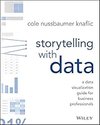
Saved by Daniel Santos and
Storytelling With Data

Saved by Daniel Santos and
McKee goes on to say that stories can be revealed by asking a few key questions: What does my protagonist want in order to restore balance in his or her life? What is the core need? What is keeping my protagonist from achieving his or her desire? How would my protagonist decide to act in order to achieve his or her desire in the face of those
... See moreClutter can make something feel more complicated than it actually is.
Create a clear visual hierarchy of information
Don’t really get this concept.
a single go-to graph for categorical data, it would be the horizontal bar chart, which flips the vertical version on its side. Why? Because it is extremely easy to read. The horizontal bar chart is especially useful if your category names are long, as the text is written from left to right, as most audiences read, making your graph legible for your
... See moreWhat exactly is story? At a fundamental level, a story expresses how and why life changes. Stories start with balance. Then something happens—an event that throws things out of balance. McKee describes this as “subjective expectation meets cruel reality.” This is that same tension we discussed in the context of plays. The resulting struggle,
... See morespecific graph types and elements
I do not recommend using blinking or flashing when communicating with data for explanatory purposes (it tends to be more annoying than helpful).
We can think of the communication mechanism along a continuum, with live presentation at the left and a written document or email at the right,